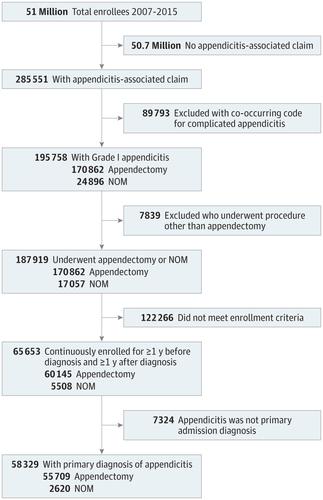JAMA Surgery ( IF 16.9 ) Pub Date : 2019-02-01 , DOI: 10.1001/jamasurg.2018.4282 Lindsay A Sceats 1 , Amber W Trickey 1 , Arden M Morris 1 , Cindy Kin 1 , Kristan L Staudenmayer 2

|
Importance Health care professionals have shown significant interest in nonoperative management for uncomplicated appendicitis, but long-term population-level data are lacking.
Objective To compare the outcomes of nonoperatively managed appendicitis against appendectomy.
Design, Setting, and Participants This national retrospective cohort study used claims data from a private insurance database to compare patients admitted with uncomplicated appendicitis from January 1, 2008, through December 31, 2014, undergoing appendectomy vs nonoperative management. Coarsened exact matching was applied before multivariate analysis to reduce imbalance between groups. Data were analyzed from February 12 through May 1, 2018.
Exposures Appendectomy (control arm) or nonoperative management (treatment arm).
Main Outcomes and Measures Short-term primary clinical outcomes included emergency department visits, hospital readmission, abdominal abscess, and Clostridium difficile infections. Long-term primary clinical outcomes were small-bowel obstructions, incisional hernias, and appendiceal cancers. Nonoperative management failure was defined by hospital readmission with appendicitis diagnosis and an appendicitis-associated operation or procedure. Secondary outcomes included number of follow-up visits, length and cost of index hospitalization, and total cost of appendicitis-associated care. Covariates included age, sex, region, insurance plan type, admission year, and Charlson comorbidity index.
Results Of 58 329 patients with uncomplicated appendicitis (52.7% men; mean [SD] age, 31.9 [16.5] years), 55 709 (95.5%) underwent appendectomy and 2620 (4.5%) underwent nonoperative management. Patients in the nonoperative management group were more likely to have appendicitis-associated readmissions (adjusted odds ratio, 2.13; 95% CI, 1.63-2.77; P < .001) and to develop an abscess (adjusted odds ratio, 1.42; 95% CI, 1.05-1.92; P = .02). Patients in the nonoperative management group required more follow-up visits in the year after index admission (unadjusted mean [SD], 1.6 [6.3] vs 0.3 [1.4] visits; adjusted +1.11 visits; P < .001) and had lower index hospitalization cost (unadjusted mean [SD], $11 502 [$9287] vs $13 551 [$10 160]; adjusted −$2117, P < .001), but total cost of appendicitis care was higher when follow-up care was considered (unadjusted, $14 934 [$31 122] vs $14 186 [$10 889]; adjusted +$785; P = .003). During a mean (SD) of 3.2 (1.7) years of follow-up, failure of nonoperative management occurred in 101 patients (3.9%); median time to recurrence was 42 days (interquartile range, 8-125 days). Among the patients who experienced treatment failure, 44 did so within 30 days.
Conclusions and Relevance According to results of this study, nonoperative management failure rates were lower than previously reported. Nonoperative management was associated with higher rates of abscess, readmission, and higher overall cost of care. These data suggest that nonoperative management may not be the preferred first-line therapy for all patients with uncomplicated appendicitis.
中文翻译:

私人保险患者中非并发症性阑尾炎的非手术治疗。
重要性 卫生保健专业人员对非手术性阑尾炎的非手术治疗表现出极大的兴趣,但缺乏长期的人群水平数据。
目的 比较非手术性阑尾炎与阑尾切除术的疗效。
设计,地点和参与者 这项全国性回顾性队列研究使用私人保险数据库中的理赔数据,比较了自2008年1月1日至2014年12月31日接受阑尾切除术与非手术治疗的单纯性阑尾炎患者。在多变量分析之前应用粗略的精确匹配,以减少组之间的不平衡。分析了2018年2月12日至5月1日之间的数据。
暴露 阑尾切除术(对照组)或非手术治疗(治疗组)。
主要结果和措施 短期主要临床结果包括急诊就诊,住院再入院,腹部脓肿和艰难梭菌感染。长期的主要临床结果是小肠梗阻,切口疝和阑尾癌。非手术治疗失败的定义为再次入院并诊断为阑尾炎,并进行了阑尾炎相关的手术或程序。次要结果包括随访次数,指数住院时间和费用,以及阑尾炎相关护理的总费用。协变量包括年龄,性别,地区,保险计划类型,入学年份和查尔森合并症指数。
结果 58 329例无并发症阑尾炎的患者(男性52.7%;平均[SD]年龄,31.9 [16.5]岁),55 709例(95.5%)进行了阑尾切除术,2620例(4.5%)进行了非手术治疗。非手术治疗组的患者更有可能发生阑尾炎相关的再入院(调整后的优势比,2.13; 95%CI,1.63-2.77;P <.001),并出现脓肿(调整后的优势比,1.42; 95%CI) ,1.05-1.92;P = .02)。非手术治疗组的患者在指数入院后的一年中需要更多的随访访视(未调整的平均[SD]访视1.6 [6.3] vs 0.3 [1.4]访视;调整后的+1.11访视;P <.001),且指数住院费用较低(未调整平均值[SD],$ 11 502 [$ 9287] vs $ 13 551 [$ 10 160];经调整后的-$ 2117,P <.001),但阑尾炎护理的总费用在随访时较高考虑了后续护理(未调整,$ 14 934 [$ 31 122]比$ 14 186 [$ 10 889];调整后+ $ 785;P = .003)。在平均3.2(1.7)年的随访中,有101例患者(3.9%)发生了非手术治疗失败。复发的中位时间为42天(四分位间距为8-125天)。在经历治疗失败的患者中,有44名在30天内发生了失败。
结论和相关性 根据这项研究的结果,非手术管理失败率低于以前的报告。非手术治疗与脓肿,再入院率和更高的整体护理费用相关。这些数据表明,对于所有并发阑尾炎的患者,非手术治疗可能不是首选的一线治疗方法。



























 京公网安备 11010802027423号
京公网安备 11010802027423号